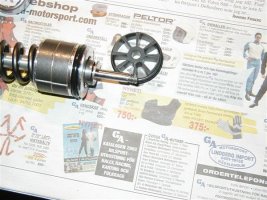Terry
Yes this is the type of setup I was refering to, a ball, seat, spring check valve for partial cartridge filling during compression. The setup could be positioned in place of the cylinder valve but obviously not in the cup area of the bottoming control device. The small jet would also allow some filling but as JW stated emulsified oil will flow more quickly than solid fluid, therefore the jet would tend to try and bleed off any cavitation emulsified fluid trapped between the upper catridge gland and the midvalve / rebound pistion assembly. This could also allow tuning via tension, ball mass, diameter, and quantity of jets and check balls. Also with reciprocating movement and moderate flow, contamination would be reduced at the seat.
In further persuing the piston port area issue and the terminal fluid velocities. Do you have the data on fork compression velocities that you would like to share?
It's possible that JW is correct in that orifice area is not a limiting factor, and since many pistons are cast and machined so that the point of pressure is not round as in a drilled hole, the pressure is placed across the entire area of the port edge, thereby changing the contact point and fluid pressure centerline.
The issue still remains though that if cavitation exists on the rebound and the check plate cannot fill without emulsifification of the fluid the midvalve will still be driven thru emulsified fluid on the next impact, however by purging the cartridge at the upper end at least there is some form of venting and recirculating the fluid. This can also hold true in regards to the base valve and refilling thru the lower checkplate, but again it can at least have a flow path.
PK
Yes this is the type of setup I was refering to, a ball, seat, spring check valve for partial cartridge filling during compression. The setup could be positioned in place of the cylinder valve but obviously not in the cup area of the bottoming control device. The small jet would also allow some filling but as JW stated emulsified oil will flow more quickly than solid fluid, therefore the jet would tend to try and bleed off any cavitation emulsified fluid trapped between the upper catridge gland and the midvalve / rebound pistion assembly. This could also allow tuning via tension, ball mass, diameter, and quantity of jets and check balls. Also with reciprocating movement and moderate flow, contamination would be reduced at the seat.
In further persuing the piston port area issue and the terminal fluid velocities. Do you have the data on fork compression velocities that you would like to share?
It's possible that JW is correct in that orifice area is not a limiting factor, and since many pistons are cast and machined so that the point of pressure is not round as in a drilled hole, the pressure is placed across the entire area of the port edge, thereby changing the contact point and fluid pressure centerline.
The issue still remains though that if cavitation exists on the rebound and the check plate cannot fill without emulsifification of the fluid the midvalve will still be driven thru emulsified fluid on the next impact, however by purging the cartridge at the upper end at least there is some form of venting and recirculating the fluid. This can also hold true in regards to the base valve and refilling thru the lower checkplate, but again it can at least have a flow path.
PK
